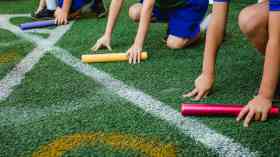The long reach of early childhood
 During the first five years of life, research has shown that a child’s brain develops more rapidly than it does at most other stages in life. 90 per cent of the vital connections are formed between the two sides of the brain, essentially establishing a stronger ability to learn new information in future life. It is important therefore to stimulate, nurture and maintain this development to make it as strong as possible.
During the first five years of life, research has shown that a child’s brain develops more rapidly than it does at most other stages in life. 90 per cent of the vital connections are formed between the two sides of the brain, essentially establishing a stronger ability to learn new information in future life. It is important therefore to stimulate, nurture and maintain this development to make it as strong as possible.
At birth the brain is incomplete, with thinking, remembering, communication and movement still developing. Imagine a child’s brain as a newly built house – while the walls, floor and electrics are in place, they will not work until the connections between them are made (Brotherson, 2005). Similarly, while we are born with many nerve cells, or neurons, it is only through experiences in our early years through to adolescence that these connections are actually made. Indeed, an average three year olds’ brain is twice as active as an adult’s.
Electric signals
When a stimulus occurs, an electrical signal is passed from one neuron to another through synapses, relaying information about what we see, touch, taste, smell, and hear. Each sensory experience forms a new pathway – the more times these connections are made, the thicker the pathway becomes, and the more accurately and swiftly this functions. The brain is programmed to produce more synapses than it will ultimately use – by eight months a baby may have 1,000 trillion synapses! (Carnegie, 1994)
Sensory-rich experiences reinforce synapses while those not used are pruned to increase efficiency. Connections used repeatedly during the early years become the foundation for the brain’s organisation and function throughout life, so it is vital to offer a stimulating environment. One of the most accessible (and cost effective) ways is through sensory play.
Engaging the senses
Many toys primarily stimulate the visual sense. The brain takes in the world through its sensory system – the external senses of sight, sound, touch, smell and taste, and the lesser known inner or sixth senses detecting position, balance and movement. Sensory play is essentially play that focuses on engaging one or more senses, adding a significant extra dimension.
The example of heuristic play, a term coined by child psychologist, Elinor Goldschmied in the early 1980s, describes play and exploration of the properties of objects. Heuristic play can stimulate all the senses, creating a rich learning experience. Key to success is the careful sourcing of stimulating objects and allowing children time and space to explore these fully and freely. As well as developing problem solving, this sets in motion the confidence and ability to be independent learners.
Understanding the process
Piaget and later Hughes identified a guide to understanding the play process. Early play is about exploration ‘What is this object?’ and ‘What is it like?’ A natural curiosity to explore and the joy of discovery keeps children entertained for hours. As children get older, they tend to play in a more complex way, combining objects and other resources to ask ‘What can I do with it?’ Finally children typically explore ‘What can it become?’ where simple objects become whatever their imagination inspires.
The recent review of the EYFS highlights the importance of explorative play. In fact, sensory play that enables children to explore, experiment and examine can target all areas of learning and development in the EYFS, making meaningful curriculum outputs commonplace. Children’s imagination, creativity and learning are stimulated, while learning about the properties of materials e.g. heavy, light, big, small, can develop problem solving, reasoning, fine motor skills and hand-eye coordination.
Responses to sensory play
Even experienced practitioners can be surprised by children’s responses to sensory play, with children engaged for almost two hours with seemingly ordinary objects. A treasure basket – a sturdy basket containing an assortment of 30 to 80 “treasures” – is ideal for encouraging sensory play. Picked for their sensory-rich appeal, contrast and variety (unlike heuristic play resources), these should include metal, stone, cardboard, wood, rubber, fabric and a mix of colours and shapes. These objects will move in different ways, have different weights, textures and properties.
The open-endedness means play naturally develops in an age and developmentally appropriate way. Within an enabling environment children can investigate objects, experiment, or be guided with activities.
For this exploration to be satisfying and free, children need space, time, access to stimulating resources and permission to get messy. By encouraging sensory play in this way we can help put children on the path to maximising the vast potential of their amazing brains. Practitioners have an important role to play in laying these vital stepping stones for children’s happy and successful lives.
About the author
Sue Gascoyne (BA, MA, MRTPI), has designed and runs workshops nationally and internationally to help practitioners introduce learning through play. She is a published author who focuses on embedding sensory play experiences in the learning environment.
Prior to launching her business Sue led a consultancy providing facilitation, mentoring and training for over nine years. Primary school governor and mother of two young children, many of the activities and resources are based on observations of her own children at play.
In 2009, Sue Gascoyne was named Nursery World ‘Trainer of the Year’ for her contribution to the Early Year’s sector.
Latest News
25/11/2025 - 13:05
New data from The Careers & Enterprise Company (CEC) finds that around two-thirds of businesses believe a two-week block of work experience is too time-consuming and offers too little benefit.
25/11/2025 - 12:57
The Youth Sport Trust has launched its latest Class of 2035 Report, warning that unless urgent action is taken to increase physical activity among children, this generation will face poorer health and outcomes.
24/11/2025 - 09:40
The Education Committee has launched a new inquiry to understand how reading can be nurtured, and what its benefits are, amid a decline in the number of children reading for pleasure.
21/11/2025 - 09:37
The framework provides a practical guide to integrating education and health for better outcomes for children and young people.
20/11/2025 - 10:42
Parents will be able to get Enhanced Disclosure and Barring Service (DBS) checks when hiring private tutors, carers and therapists, among others.







